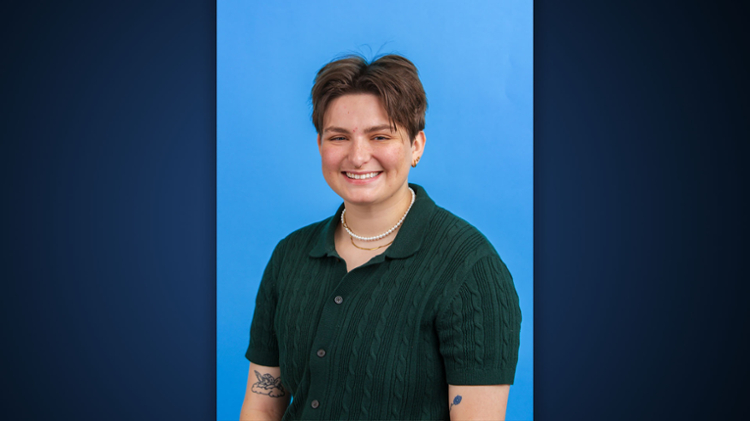‘Tres Vidas’ Reveals Three Distinct Latina Voices, Stories
CORPUS CHRISTI, Texas – The complex lives of three Latina historical figures share the stage in “Tres Vidas,” a one-woman chamber music theatre work starring Jenyvette Vega. The three-act performance, in which Vega portrays famed Mexican painter Frida Kahlo, Salvadoran Army massacre survivor and peasant activist Rufina Amaya, and Argentinean poet Alfonsina Storni, includes musical accompaniment consisting of cello, piano, and percussion.
“Tres Vidas” plays the Performing Art Center at 7:30 p.m. on Tuesday, March 19, as part of Women’s History Month at Texas A&M University-Corpus Christi. KSAB-FM is the presenting radio station for the event and KSAB-FM personality and “Domingo Live” co-host Barbi Leo will serve as emcee. Following the performance, Leo will moderate a panel that includes Vega, Dr. Claudia Rueda, assistant professor of History, and Performing Arts Center Director James Moore.
“When the idea of presenting ‘Tres Vidas’ was suggested to me by the Dean of Liberal Arts, Dr. Mark Hartlaub, I didn’t hesitate to say ‘yes’,” said Moore. “This work is incredibly well-constructed and the performers give so much when they’re on stage. I also believe it’s important for the PAC to represent the Corpus Christi community and continue to find performances for future seasons like ‘Tres Vidas,’ that reflect our entire community.”
Based in New York City, Vega said by phone that she is in her second season with “Tres Vidas,” which was written by celebrated Chilean-American writer Marjorie Agosín and is presented by Core Ensemble.
“The show has been touring for about 16 years,” Vega said. “The original actress is my director, Rosa Rodriguez, so a lot of the stuff that she used to do, I’m doing now.
“For this particular show, it’s just me relying on myself – and I have people relying on me – so it’s a completely different task. It’s very challenging to take three very different, very strong Latinas and try to differentiate them so the audience doesn’t get lost.”
The work opens with Vega as Frida Kahlo, whose acclaimed paintings often referenced the physical pain that stemmed from a near-fatal bus accident when she was 18 as well as the emotional pain she endured during the course of her turbulent relationship with fellow Mexican artist Diego Rivera.
“I’m the closest to Frida in the way she carries herself,” Vega said. “As an actress, the challenge is to make each character as specific as possible so the audience forgets that I’m Jeny the actress and that they see that I am Frida, I am Rufina, I am Alfonsina. I think the show does an amazing job of elevating the voices of these women.”
The second act adopts a darker tone to fully transition to the world of Rufina Amaya, the lone survivor of the 1981 massacre of more than 800 villagers in El Mozote in El Salvador at the hands of the Salvadoran Army. Amaya lost her husband and four children in the massacre, according to a New York Times obituary following Amaya’s death as a result of a stroke in 2007.
“In the beginning, it was a bit challenging because you exit the stage with one emotion and it’s very difficult to turn it off and to turn on the next one,” Vega said. “I have three to five minutes in between each scene, so that’s where the music comes in: The music helps me get into the mindset of ‘I’m done with Frida; it’s time for Rufina.’ Music really is an essential part of the show.”
Vega said she sees a personal parallel in Rufina’s story with her own life story.
“I connected with Rufina’s story the most because my family is from Puerto Rico,” Vega said. “After Hurricane Maria, there was a sense of hopelessness and of not knowing where your family is and having to do what you can to survive while you feel that everything around you is crumbling – so Rufina’s story is very real to me.”
The production closes with the life and times of Alfonsina Storni, best-known for her 1918 collection of poems called “El Dulce Daño” (“The Sweet Injury”). The scene opens with Vega singing “Alfonsina y El Mar” (“Alfonsina and the Sea”) which was a popular ballad recorded by Argentine folk singer Mercedes Sosa that pays tribute to the poet and references her suicide at a beach in 1935.
“In Alfonsina, the story is based on memories: She tells you how her life was,” Vega said. “She tells you about her poems – Alfonsina gets to read two of her poems – and so the poems help you to know her state of mind.”
Vega said her goal is to have the audience connect with each character’s life and discover the rich distinctiveness of each story.
“I think it’s really important – especially in this day and age that we’re living – that I as an actress give a voice to strong and diverse Latina women,” she said. “That’s why it so important to me to make each character as specific as possible in their words, in how they look and how they act: They’re very different. If someone leaves the theater inspired to want to learn more about these women, then I’ve done my job.”





















